🔥 Trending Searches
- Papasan
- Candles
- Pillows
- Curtains
- Mirror
- Li Bein
- Dresser
- Dishes
- Mirror
- Chair
- Desk
- Plates
- Bar Stools
- Rugs
- Vase
- Lamps
🔥 Trending Searches
🔥 Trending Searches
SEARCH OUR PRODUCTS AND CATEGORIES
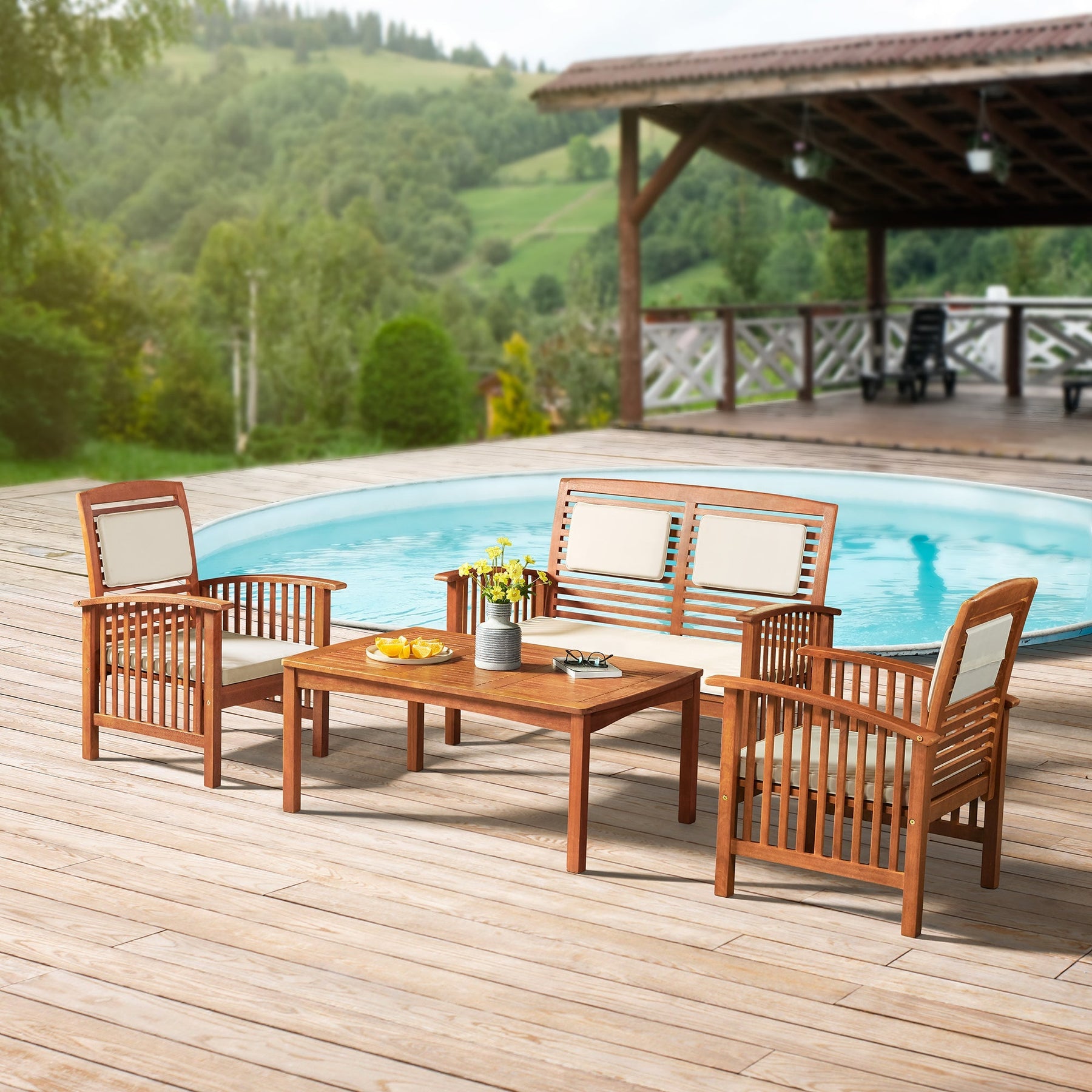
Summer is in full swing! With the weather coming in hot, it calls to create the perfect patio setup that ticks all boxes for sun-drenched activities. What exactly constitutes an all-encompassing alfresco oasis? Function, comfort, and style are at the top of the list. It’s the twin to your indoor rooms that will make you want to lounge just as long as within your four walls.
But while those elements are important, durability tends to get overlooked in place of them. A homey and stylish zone consisting of outdoor dining furniture pieces and accessories also needs to weather the storm, survive the heat, and stand the test of time whatever the season. This is where finding the right materials comes in and is fundamental to making worthwhile furniture investments.
Certain materials can last through any type of weather but may not be as flexible to movement. Or they might be perfect for the look you’re going for but would need extra maintenance for weatherproofing. Let’s look at the different options.
It’s the most lightweight and low-maintenance of the bunch. Aluminum offers ease when moving things around in your space and requires no treatment with its rust-proof quality.
Timeless and strong, steel checks all the outdoor requirements with its ability to hold out against harsh winds. It’s even a breeze to paint without denting the surface, making it the perfect material for firepits and patio heating. However, its durability comes with heftiness and is not ideal when moving furniture.
Synthetics are light, sturdy, and easy to clean—with some designed to mimic the look of wood and wicker, particularly with resin which achieves the modern outdoor aesthetic wonderfully. Although in comparison to its natural counterparts, it doesn’t match up to durability and isn’t as elegant.
Wood is unarguably the most popular choice for patio furniture. Choosing the right type of wood is crucial to avoid bugs and splitting. Maintenance-wise, it’s quite high with a need for regular preservative treatments for weather and UV protection.
Rattan provides that warm, casual look that makes an outdoor space feel so chic. It’s eco-friendly, naturally insect-resistant, and much softer and longer lasting than synthetic rattan. The only caveat is that it’s more suitable indoors and needs to be weatherproofed for protection.
Tips For Choosing The Best Outdoor Furniture
Treating your outdoor spaces with the same care as your interiors will be your best decision in the long run. It’s more economical and less of a chore on your to-do list without having to think of constant replacements and tedious maintenance. These are the mistakes you never want to make when buying outdoor furniture.
Do you live in a rainy city? Is it hot and dry? Does the sun shine directly in your backyard? Think of these questions firsthand before making any outdoor purchases. Moisture can develop rot, hot and dry conditions can cause cracks and splinters on wood, winds may blow away aluminum, while sunlight fades paint, bleaches fabrics, and degrades plastic.
A material being “weatherproof” relies on its type. Hardwoods like teak, eucalyptus, and acacia are the most hard-wearing timbers, steel requires treatments like a powder-coated finish to form a resistant barrier against rust and moisture, and aluminum would be best invested with an all-welded design. Natural rattan is far more delicate and is most suited for a covered porch.
The starting point is your furniture and area measurements —double check and write these down to make sure everything fits your space well. Have masking or painter’s tape cut to the size of the item to map out the spot it will be placed in. If the furniture is close to a wall, take height into consideration as well. From there, create a layout plan to arrange your furniture in a way that meets your specific entertaining needs.
Ultimately, your budget will determine what you can put in your space. It would be smart to buy the best you can afford instead of skimping on quality. You’ll end up getting more value for your money overtime than with pieces that are less durable. If you want to lessen expenses, pick materials that are cost-efficient but still hard-wearing such as aluminum, heavy-duty resin, or eucalyptus wood. Buying secondhand is also an eco-friendly option.
The front porch is a chance to make a great first impression for your home. Create a sunset-watching zone with laid-back lounge seating like sofas and loveseats, patio sectionals, and a bench cozied up with outdoor pillows. You can enhance your curb appeal too by decorating with planters that match your exterior walls’ colors.
A well-manicured garden is best complemented with a sleek socializing space. Opt for a L-shaped patio furniture fronted by a firepit and patio heating for an instant entertaining hub. Take it up a notch for open-air parties with a wide, rectangular dining set, contrasting chairs, a warm outdoor lighting setup for a modern feel. Add sculptures and decor for that extra oomph.
Make your backyard a casual get-together spot with the classic combination of sofa, loveseat, and lounge chairs. For smaller gatherings, introduce a touch of French charm with café-style bistro sets perfect for afternoon tea or me time with your morning coffee. Add yard lights and outdoor rugs to rival a set-up from a home magazine’s page.
Limited spaces call for some smart arrangements. Appoint statement seating like hanging bench swings and papasan chairs with layers of shapely, bright pillows. You can make it a cozy nook for alone time or catch-ups as well with sofas and loveseats, bean bag chairs and fuzzy throws atop an area rug and hang pendant lights to illuminate.
Your dream patio isn’t complete without details. Beyond being beautiful décor, accessories can forge a warm, inviting touch to even the largest of spaces. Here are the best additions to elevate your outdoor furniture.
1. Outdoor Pillows
Overlap different shapes and sizes of cushions with vibrant covers to boost your conversation zones from lounge chairs to modular sectionals.
2. Outdoor Rugs
These elegantly tie the space together by grounding furniture and presenting it with a sense of scale. Make sure it’s made of weatherproof materials to avoid mold and mildew.
3. Planters
Greenery is always necessary to breathe life into an area. Make it pop with colored pots set upon stands, save space with wall mounts, or conjure up a rustic feel with hanging planters.
4. Outdoor Lighting
Nothing enhances the atmosphere like good lighting. Hang vintage-inspired bulbs for a romantic ambiance to your dinner parties or make a balcony more modern with geometric pendants.
Paying attention to care instructions is the best way to assure longevity for your outdoor furniture. Knowing the suitable tools and treatments to clean and cure allows you to get the most bang for your buck. Take note of these quick steps to maintain your furniture effectively.
1. Wood
For most woods, you can remove light debris with a soft bristled brush and clean the surface using a sponge with mild soap and lukewarm water. Let the wood dry naturally. For hardwoods like teak and eucalyptus, apply a protective sealant to preserve its natural color.
2. Steel
Lightly spray with a garden hose to eliminate dirt and wipe down with a cloth. Rinse, repeat, and dry it off with a microfiber towel. White vinegar can also be a solution for fingerprints and smudges.
3. Aluminum
By far the easiest to work with because of its powder coating. A soft cloth and non-abrasive liquid cleaners will do the trick to remove scuff marks.
4. Plastics
Due to its tendency to degrade in direct sunlight, plastics can develop a chalky finish. Sprinkle baking soda on a damp sponge to the affected areas and once dry, apply automotive paste to restore the material’s shine.
Coverage is a must when it comes to protecting your outdoor furniture.
In summary, an outdoor space is an extension of your home’s indoors—so it’s a no-brainer that it has to be just as welcoming and carefully thought-out. Take extra measures to study the materials, pay attention to details, and learn the proper maintenance to make the most out of your investment. With all these guidelines in mind, you’ll be able to build your dream outdoor sanctuary in no time.
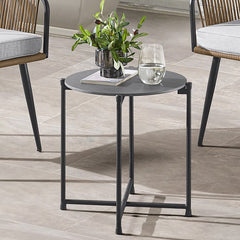
Alburgh All-Weather 18" H Cocktail Table
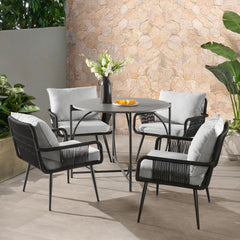
Black Andover All-weather Outdoor Bistro Set with Four Rope Chairs and 30" Bistro Table
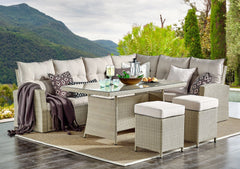
Cream Canaan All-weather Wicker Outdoor Deep-seat Dining Sectional Set with Sofa, Loveseat, 26" Cocktail Table and Two Stools
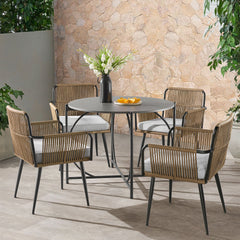
Alburgh All-Weather Outdoor Bistro Set with Four Rope Chairs and 30" H Bistro Table
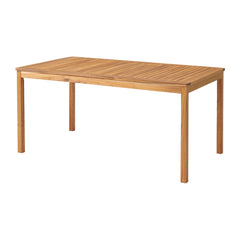
Natural Okemo Acacia Wood Outdoor Dining Table
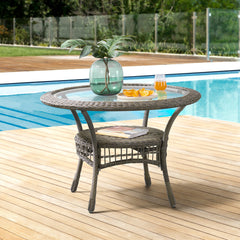
Kobo Gray Carolina 42" Diameter All-weather Wicker Outdoor Dining Table with Glass Top